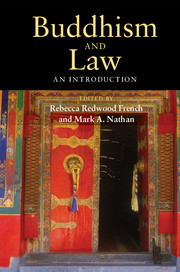Book contents
- Frontmatter
- Dedication
- Contents
- Maps and Illustrations
- Contributors
- Preface
- Abbreviations
- Introducing Buddhism and Law
- Part I The Roots of Buddhism and Law in India
- Part II Buddhism and Law in South and Southeast Asia
- Part III Buddhism and Law in East Asia
- 11 Buddhism and Law in China
- 12 The Ownership and Theft of Monastic Land in Ming China
- 13 Buddhism and Law in China
- 14 Buddhism and Law in Korean History
- 15 Buddhism and Law in Japan
- 16 Relic Theft in Medieval Japan
- Part IV Buddhism and Law in North Asia and the Himalayan Region
- A Selection of Readings
- Index
- References
15 - Buddhism and Law in Japan
Published online by Cambridge University Press: 05 August 2014
- Frontmatter
- Dedication
- Contents
- Maps and Illustrations
- Contributors
- Preface
- Abbreviations
- Introducing Buddhism and Law
- Part I The Roots of Buddhism and Law in India
- Part II Buddhism and Law in South and Southeast Asia
- Part III Buddhism and Law in East Asia
- 11 Buddhism and Law in China
- 12 The Ownership and Theft of Monastic Land in Ming China
- 13 Buddhism and Law in China
- 14 Buddhism and Law in Korean History
- 15 Buddhism and Law in Japan
- 16 Relic Theft in Medieval Japan
- Part IV Buddhism and Law in North Asia and the Himalayan Region
- A Selection of Readings
- Index
- References
Summary
Introduction
The study of the relationship between Buddhism and law in Japan has developed only in the twentieth century. The pioneering work of scholars like Miura Hiroyuki and, especially, Hosokawa Kameichi, attempted to understand Japanese Buddhism within larger historical contexts, but it was not until recently that more extensive examination was undertaken. Given the limited amount of existing scholarship, the lengthy span of Japanese history, and the restrictions of space, this overview is primarily concerned with the developing relationship between Buddhism and law in the medieval era (ca. 950–ca. 1600 CE), providing only a brief consideration of the other historical periods.
Buddhism and Law in Early Japan
The Ritsuryō code of 718, patterned partially on Tang legal codes, issued a set of specific guidelines for the behavior of Buddhist monks and nuns in its seventh section entitled “Laws for Monks and Nuns” (sōniryō). While prohibiting acts not directly discussed by the Buddhist precepts, such as military training or action, the code also clearly intersected at points with the Vinaya, such as subjecting those who make false claims of enlightenment to civil law. In each temple, three monk administrators (sangō) were to keep the monastic register and oversee any changes in status, such as a monk’s or nun’s decision to return to lay life as well as other petitions, most of which required record keeping and government notification; they were, moreover, required to mete out the punishment for infractions – typically, labor on monastery grounds.
- Type
- Chapter
- Information
- Buddhism and LawAn Introduction, pp. 273 - 287Publisher: Cambridge University PressPrint publication year: 2014



